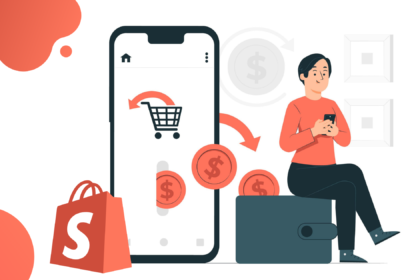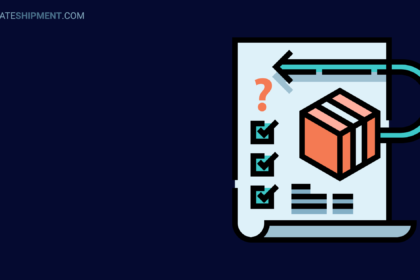Here’s the thing — returns are a great benefactor to your CX but that’s only when they’re handled right. If they are left unchecked and run rampant, they can have serious consequences for your business across multiple areas. Additionally, these consequences will be long-lasting.
Therefore, it is important to address a high return rate to ensure you handle returns effectively. Here, we discuss everything you need to know about e-commerce return rate, some common reasons, and their impact on your business to strategies to reduce return rates and future trends!
Understanding E-commerce Return Rate
The E-commerce return rate is an online shopping metric that measures the percentage of purchases returned by customers. It informs you of the frequency at which your customers order a product and return it—the reasons for which can be myriad, from unmet expectations to delayed delivery.
This critical e-commerce metric is calculated with the following formula:
Products Returned/Products Sold x 100 = Ecommerce Return Rate
Let’s say you sell 20,000 products in a year, with 4000 orders getting returned. In this case, your return rate would be:
4000/20,000 x 100 = 20%
In this case, your return rate would be 20%. Naturally, you want your e-commerce returns to be low because an e-commerce business is not a game of passing the parcel. But apart from sidestepping some troubling consequences of high returns (we’ll discuss this ahead), actively taking steps to keep returns low also has notable benefits, such as:
Despite manual processes, lower return rates translate to a reduction in return processing time for your customer support and operations teams
Understanding the true cost of returns helps you make cost-cutting decisions that impact your bottom line and help you save on returns-related revenue
With streamlined international operations (less time taken for returns), there is a huge opportunity to provide an enhanced return experience for your shoppers
Customers satisfied with their returns experience are more likely to return, thereby leading to an increase in repeat purchases
Now that we know what the e-commerce return rate is, let’s discuss what drives it, i.e., why customers return products in the first place.
Reasons for E-commerce Returns
The average e-commerce return rate today is 30%- over three times the return rate for brick-and-mortar stores. When you see this, and your first assumption is that customers are returning their purchases because they looked different online, congratulations, you’re correct!
Remember, understanding why customers return products is crucial in cutting return rates. Hence, we’ll go further on the most common reasons:
- Product issues: Mismatches in sizing/color/style, faulty products, or products not simply living up to the customer’s expectations — you name it. All of the above are immediate return triggers. Customers at physical stores touch and feel the product they’re about to purchase, but since the room for this is eliminated in e-commerce, there’s a high chance that the product doesn’t live up to their expectations in terms of quality or performance.
- Order issues: On the same lines as product issues, these are cases when the wrong item or quantity is shipped out, when the customers change their minds or make an impulsive purchase, or when the order gets delayed or damaged to the extent that the customer no longer needs it.
- Customer issues: Hate to say it but not all returns are valid. Some customers wear items and then return them for a refund in an act called ‘wardrobing’. These customers are serial returners who don’t really intend to keep their purchase.
As we touched upon earlier, analyzing common return reasons can be a great start in implementing tailor-made strategies to address these issues and reduce return rates. But before we get to the ‘how’, there’s something more important to take note of. The stakes in a story, the motive in a crime, the science in sci-fi — why do e-commerce merchants need to cut down return rates in the first place?
Impact of High Return Rates
To start with the most pressing issue up front, frequent returns lead to several operational challenges like increased workload and complexities for the staff from restocking inventory that is already time-consuming and expensive.
To add more trouble, a lengthy and difficult return process also has the power to hurt customer relationships and can erode your customer’s trust in your brand. These dissatisfied customers are prone to share their negative experiences, thereby hurting your reputation.
Ultimately, both these occurrences represent a loss in revenue, directly impacting profit margins. Not to forget the increase in the risk of fraudulent returns and refunds that come with them.
But there’s got to be a logical explanation behind everything right? Return rates being high is a phenomenon but why do they happen? Why do customers return their purchases for which they’ve waited for long enough?
Strategies to Reduce Return Rates
Now that we’ve discussed what the e-commerce return rate is, its reasons, and its impact on your platform, it’s time to discuss strategies to help keep it in check. Here’s a look at these:
Product-related improvements
Make sure you try as much to replicate the shopping experience of a physical store. This can be achieved through:
- Detailed information about the extensive features, the exact dimensions, the materials it is made up of, and care instructions, if any.
- High-quality images and videos that showcase the product in 360 degrees across multiple angles
- Accurate sizing information and recommendations (70% of all e-commerce returns are size-and-fit related)
- Encouraging customers to share their experiences on a particular product to motivate others to make a decision
- Major brands such as Gucci, Burrow, and Allbirds have been integrating with Augmented Reality (AR) solutions to display how the product would look at the customer’s place or how they would look in a particular outfit
Such comprehensive information about the product gives the shopper even more knowledge on what they’re getting into and prevents returns arising from impulsive decisions.

Optimizing the post-purchase CX
Did we mention that returns are a necessary evil? If not, here’s it. Returns might seem like a headache when you see them coming in initially but with the right CX efforts, you can not just minimize returns but can also ensure that your customers don’t consider returns as a ‘bad thing’ and still choose to shop with you.
Might seem like a domino effect but delivering products promptly and safely holds the power to reduce the likelihood of returns due to delayed or damaged shipments. For delays, ensure that there is transparent communication via regular shipping updates so that your customers don’t blame you for the delay in the first place. To prevent damaged goods and thereby reduce the return rate, you need to protect the package’s contents with high-quality packaging.
In the event such incidents happen despite strict measures and the return is initiated, proper and proactive support from your end can mitigate frustration and ensure that your customers give you another chance. For instance, you can start by acknowledging the mistake, ensuring that an action has been taken (refund, replacement, or offering discounts on upcoming purchases as compensation), etc.

Not just shipping and delivery but even return experiences play a significant role in optimizing your post-purchase CX. While this may seem like a long game, making improvements to your returns process indeed has the power to cut down returns.
This starts with a clear and concise returns policy that highlights return windows, non-returnable items, and more; moves to a seamless returns experience that removes any kind of hassle and makes the whole process stress-free thereby improving customer satisfaction, fostering trust and loyalty; and ultimately ends with the opportunity to collect customer feedback and gain insights into returns data that can help pinpoint issues and lead to improvements that prevents return in the future.
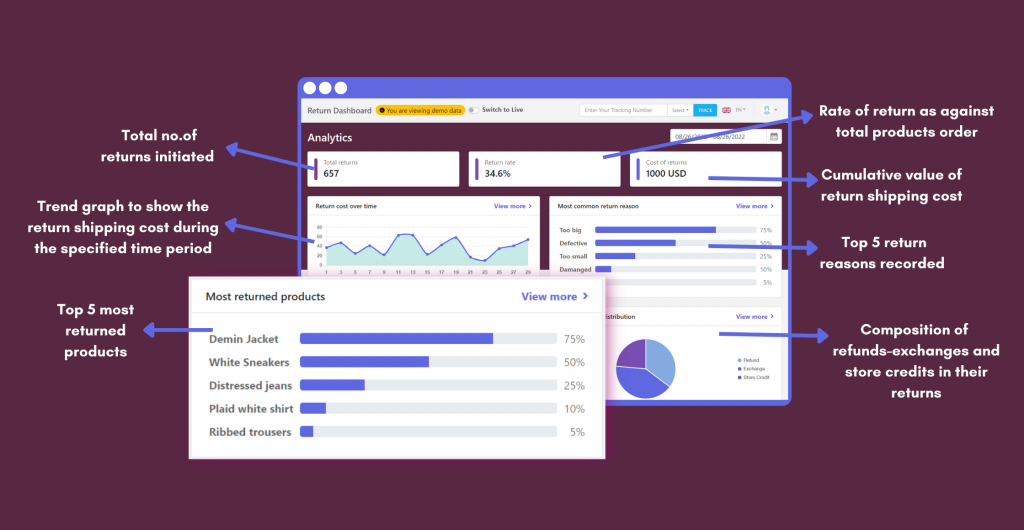
Promote exchange or store credits over refunds
“How is making the customer opt for an exchange or store credit over refunds/chargebacks going to help me cut down returns?” is a valid question to ask. And to answer that question, no it doesn’t. At least not directly.
While exchanges don’t reduce return rates per se, they help cut down the impact of frequent returns and make sure you’re spending much less than what you were going to.
Here’s how it works.
An exchange instead of a refund on product returns means you still have to pay for all the return-associated costs such as processing, replacements, and labor costs.
However, here’s where things get different. In cases of returns like a damaged product, a late delivery, or one from a wardrobing customer, there’s a possibility that a refund might be the last time you hear from the customer. By simply replacing money with another product, you now have an opportunity to not just keep the sale but you can also provide an even better CX to delight and build loyalty.
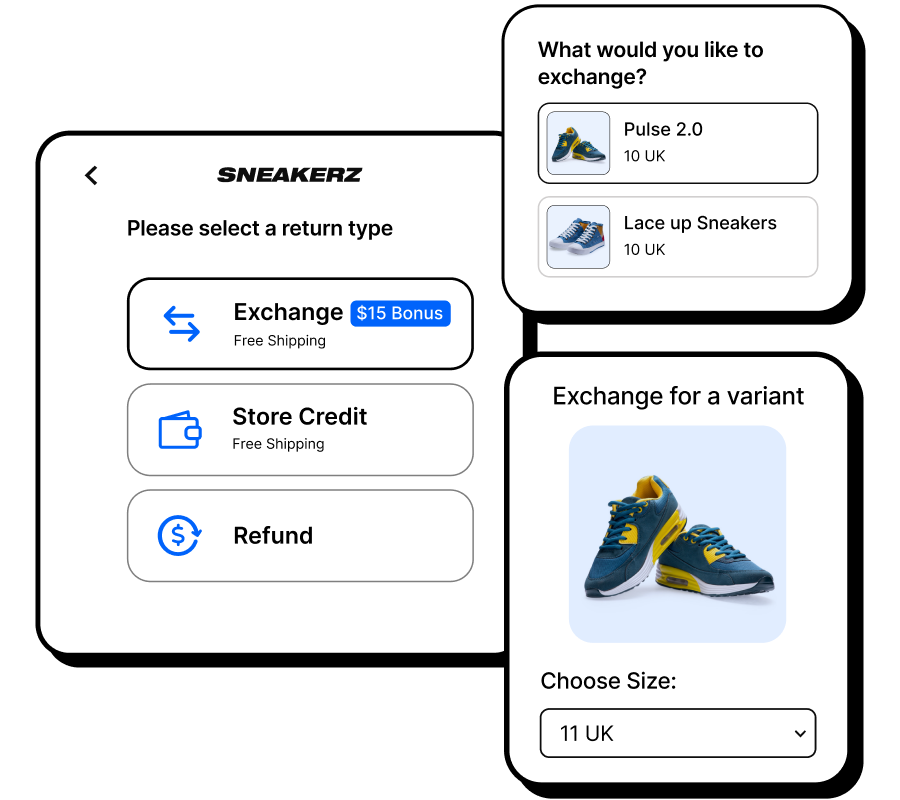
P.S. This doesn’t mean you simply eliminate offering refunds altogether as it can put the customer in a spot, i.e., force them to keep purchasing and result in a bad return experience. Instead, you can get creative and encourage exchanges or store credits over refunds via incentives.
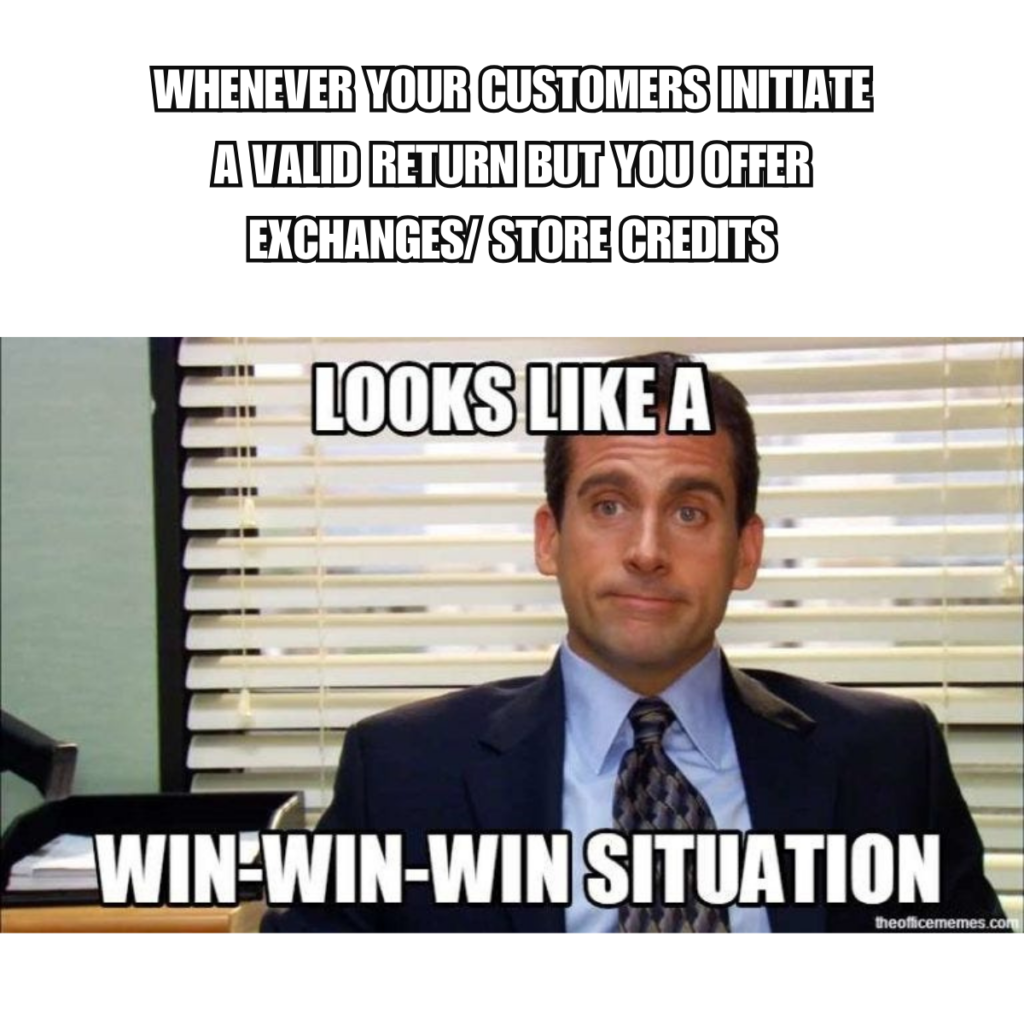
Turning Returns into a Positive Experience
Returns don’t have to be the villain in your e-commerce story. In fact,92% of shoppers say they will buy again if the returns process is easy.
LateShipment.com’s Returns Experience Management platform empowers e-commerce businesses to offer seamless, self-service returns and exchanges. Features like customizable return portals, proactive status updates, and returns label generation not only delight customers but also free up your support team to tackle more pressing issues.
By transforming returns into a hassle-free experience, you can boost customer loyalty and turn potential pitfalls into opportunities for growth.
The Role of Customer Feedback
You might have undertaken rigorous market research, created a bulletproof Ideal Customer Profile (ICP), and analyzed a plethora of sales reports, giving you the impression that you know your customers, their struggles, pain points, and preferences to the T.
But nothing, and we repeat—nothing can quite substitute hearing it directly from them in the form of customer feedback. Because at the end of the day, without customer feedback, you’re inferring and not really knowing.
Sure, seeing positive reviews warms our hearts, but negative ones are where the value truly lies. You see, customer feedback helps you make a beeline to what’s not working and jeopardizes your sales, customer experience, and, ultimately, revenue goals.
Address these, and you don’t just improve your customer experience but also effectively communicate how much you value their opinion and feedback. And when customers feel heard and seen, they’re more likely to continue associating with your platform. Consider collecting feedback through post-purchase surveys to ensure you get their input while their interaction with your e-commerce business is still fresh in their minds.
Return Policies and Their Effectiveness
Did you know that almost 70% of customers first check the returns page before deciding to make a purchase? Why? Because they want to understand whether you have one that allows them to return the product effortlessly should they need to. It gives customers confidence and a sense of security while making purchases from your e-commerce platform.
A return policy is a document that clearly lays out the process or returns from the acceptable conditions (return reasons, return window, etc.) under which your e-commerce business will accept a return, whether you will issue a refund, store credit, or exchange in lieu of the returned item.
A return policy is crucial to the smooth functioning of your e-commerce platform and helps reduce your return rates. It does this by ensuring customers make informed purchases (reducing the chances of impulse buys) and setting customer expectations as to what can and cannot be returned, reducing the likelihood of returns based on unrealistic expectations and misunderstandings. Apart from this, return policies also offer the following benefits:
- Drives customer satisfaction and loyalty by facilitating a smooth and consistent returns process.
- Prevents fraud by clearly stating return requirements like return window, original packaging, and other limitations.
- Improves the return process by offering a structured approach to returns, allowing e-commerce platforms to streamline their returns sorting process and coordinate with inventory teams efficiently.
Future Trends in E-commerce Returns
E-commerce returns have long been a headache for retailers, but the future looks a little brighter (and smarter). As technology evolves, businesses are shifting from damage control to proactive return management. Here’s what’s on the horizon:
- Virtual Try-Ons & Augmented Reality
Say goodbye to the guessing game! AR-powered virtual try-ons for clothing, eyewear, and even home décor will help customers make more confident purchases, slashing return rates.
A case in point is IKEA. This Swedish furniture company launched the IKEA Place app, allowing the customer to virtually place IKEA furniture in their spaces to gauge how it would look. All customers have to do is point their cameras at the space and place the furniture virtually to check out whether it fits their expectations.
This handy feature allows customers to make more informed decisions, reducing surprises post-delivery and, consequently, return rates.
- Instant Refunds & Exchange Optimization
No one likes waiting for refunds. E-commerce businesses can leverage automation like LateShipment.com’s Returns Experience Management software to process returns faster, offering instant refunds, store credit, or exchanges to keep customers happy (and spending).
With LateShipment.com, e-commerce businesses can offer branded returns tracking portals (accessible from their store front), share customized return updates, help customers generate returns labels, and more for a hassle-free experience.
- AI-Powered Returns Prevention
Artificial intelligence is stepping in to help streamline e-commerce returns. Many returned items can’t go back on shelves due to missing packaging, minor damage, or seasonality, forcing retailers to liquidate or discard them.
AI is changing the game by assessing product conditions, tracking return patterns, and analyzing demand in real time. From restocking and refurbishing to dynamic resale pricing and recycling, AI helps retailers recover maximum value. AI-powered image recognition also streamlines inspections, cutting costs and transforming returns from a loss into a revenue opportunity.
Conclusion
Returns are not just inevitable but are absolutely necessary for every business. Cutting down return rates doesn’t mean you simply avoid allowing returns at all (that can do more harm than good). Instead, you can try to cut down unwanted returns wherever possible to reduce workload, costs, etc.
The steps that we’ve covered in this article should give you insights into how you can proceed with reducing your returns. Instead of manually implementing them (the hard way), you can easily take control of all your returns from a returns center that makes the initiation self-service, automates the process, provides intelligence, and retains revenue.
LateShipment.com’s Returns Experience Management helps you do just that. LateShipment.com is an incredibly simple way of managing e-commerce returns — fully self-serve and automated for you and your shoppers alike.
Learn more about how LateShipment.com’s Returns Experience Management can work for you, help you reduce your store’s return rates, and offer return experiences that your customers truly love — talk to us today.




